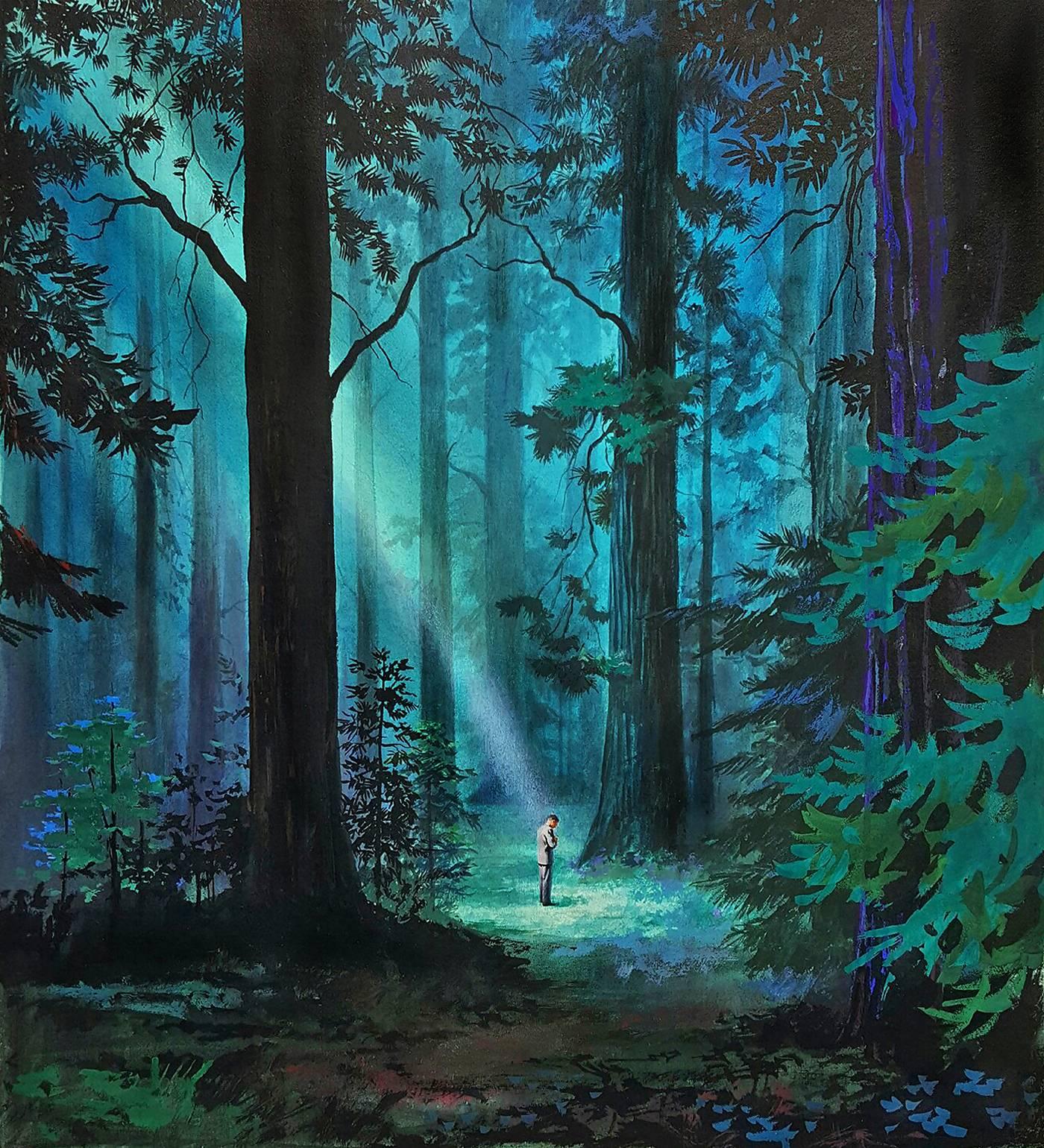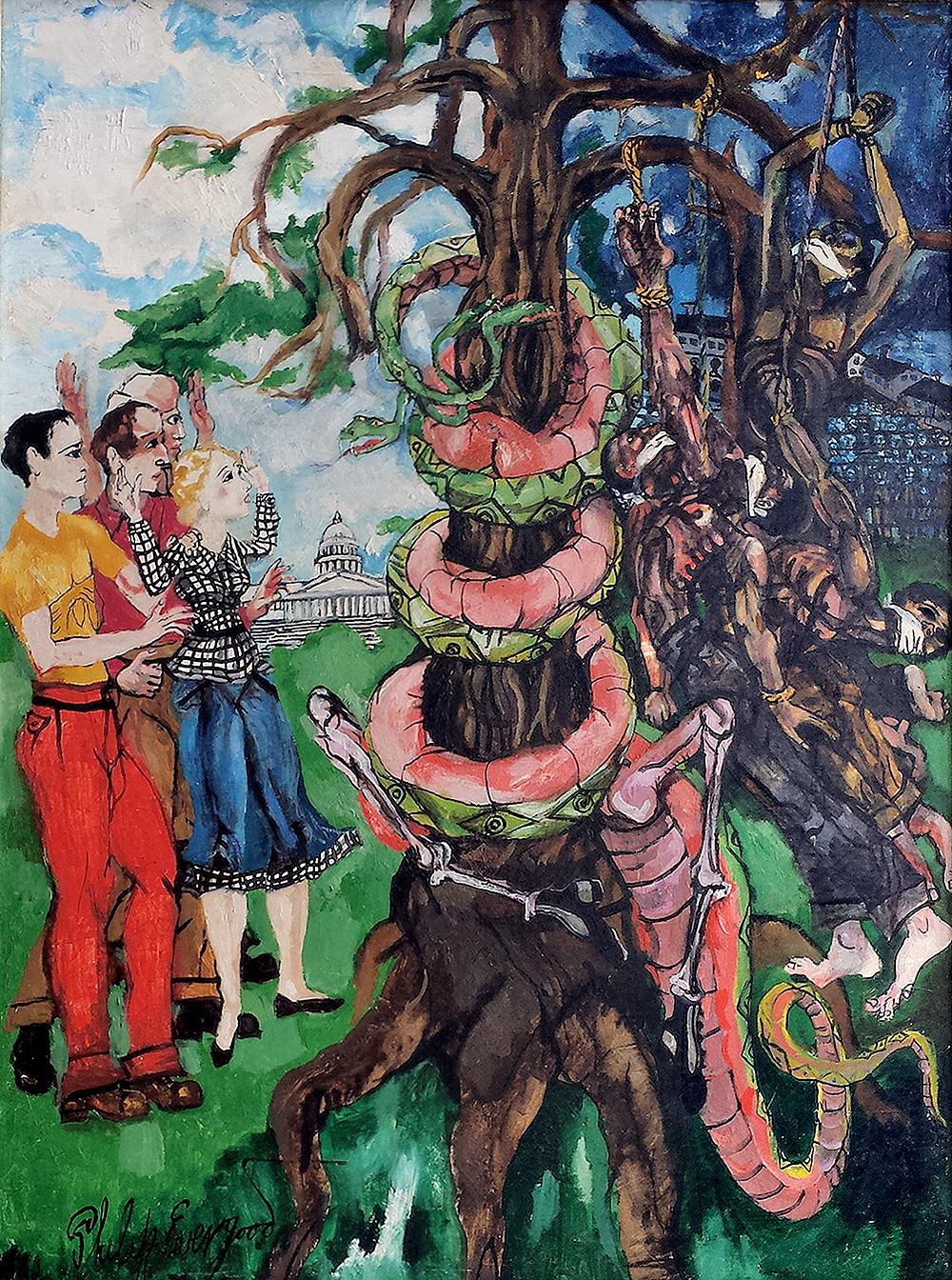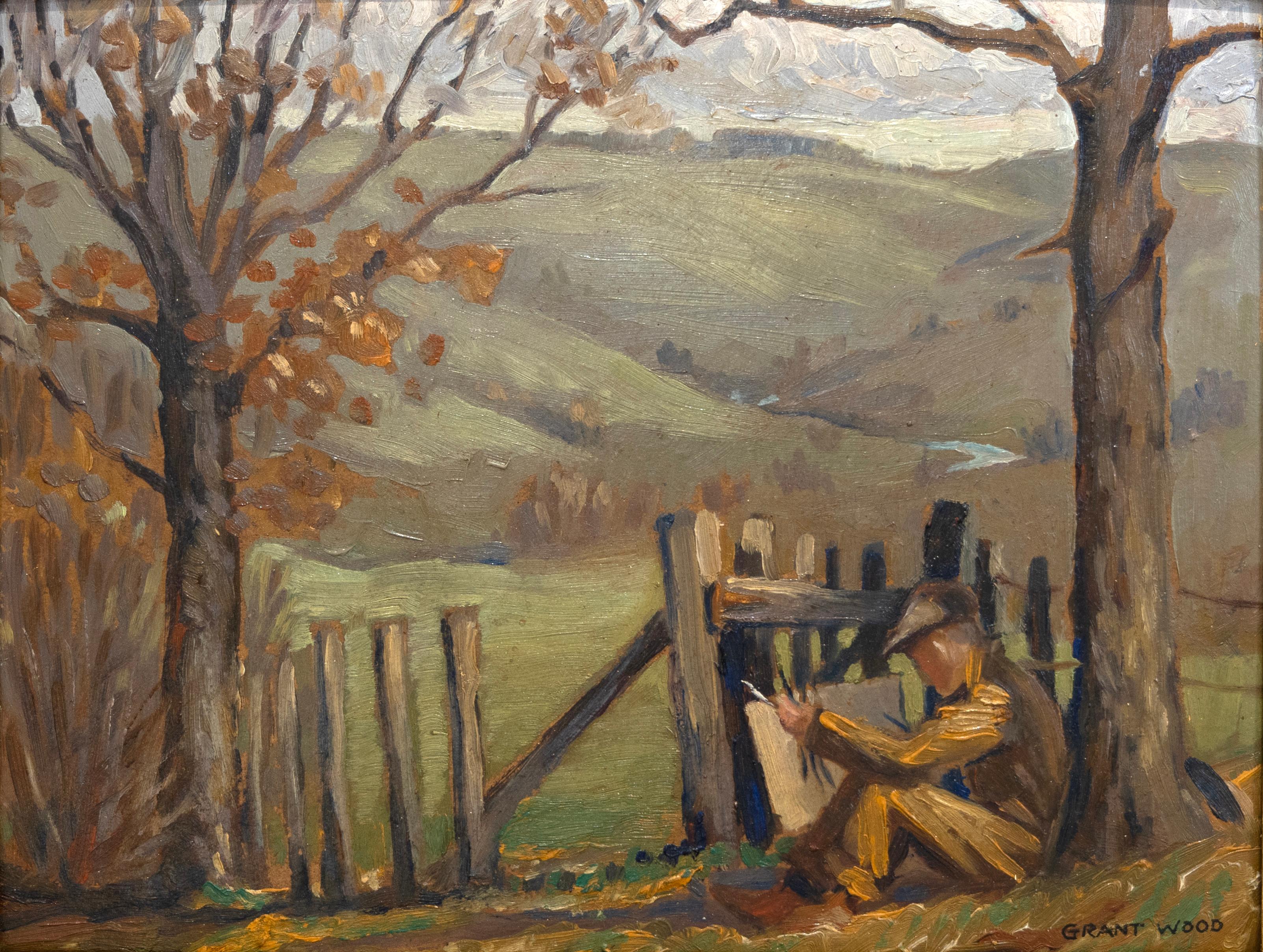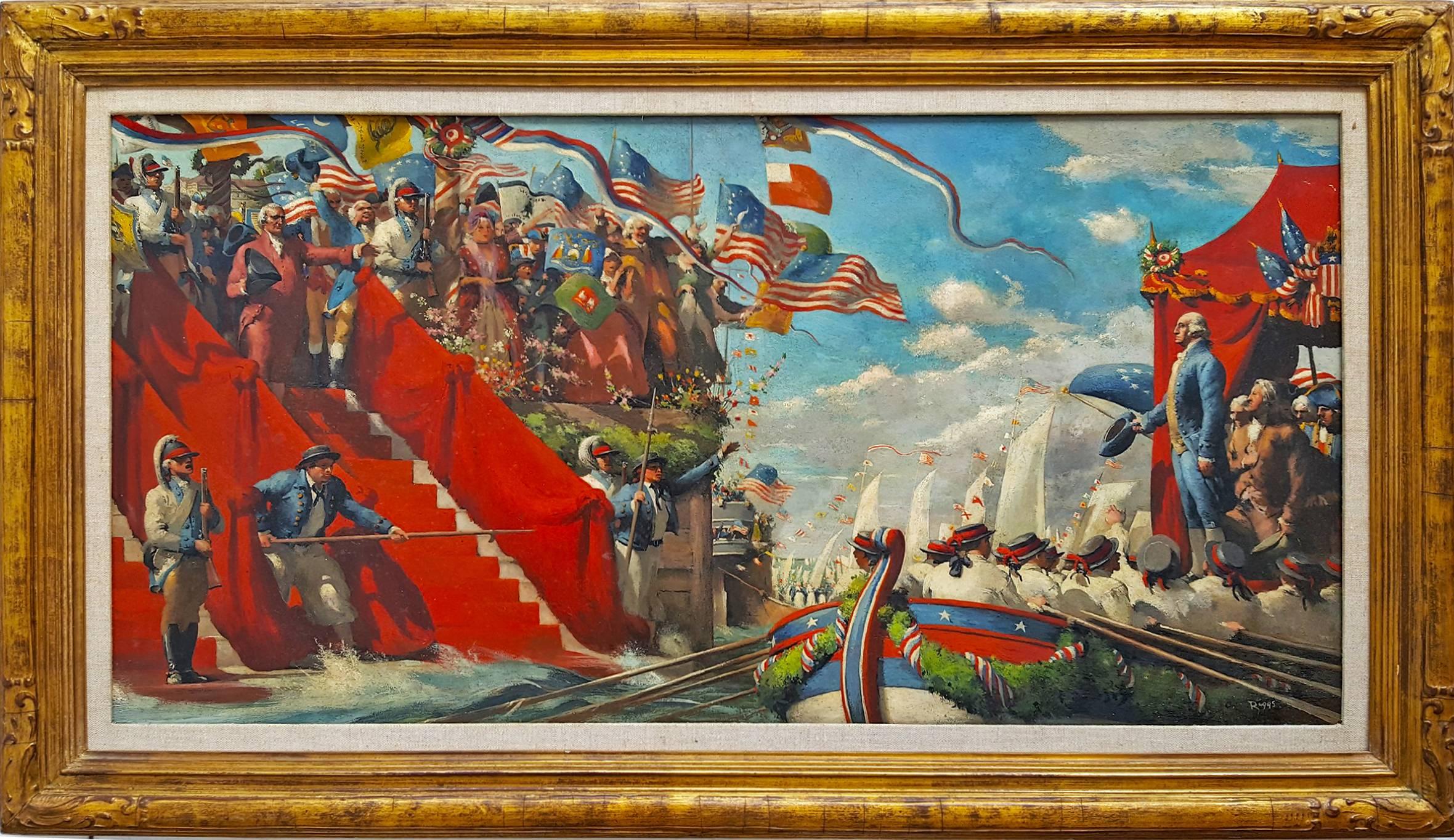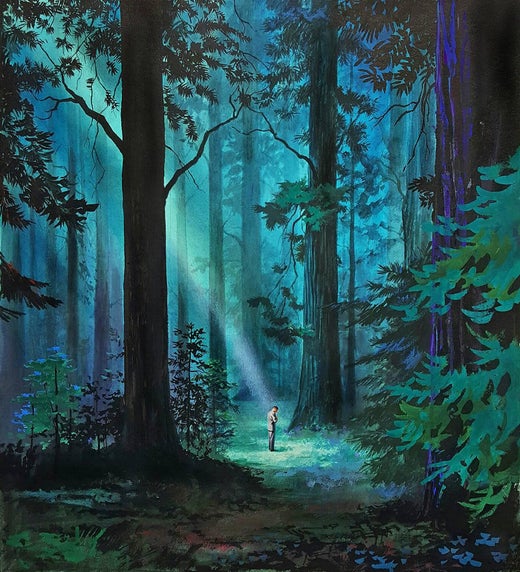Items Similar to A ray of light in the forest - Surreal Man in Surreal Landscape
Want more images or videos?
Request additional images or videos from the seller
1 of 7
Hector GarridoA ray of light in the forest - Surreal Man in Surreal Landscape 1970
1970
About the Item
Hector Garrido is an American book cover illustrator. He illustrated numerous science fiction, horror and adventure book covers, including all the covers for the Baroness series of pulp novels, and covers for the Destroyer series. He also illustrated romance and gothic novels, and Nancy Drew and Hardy Boys novels. Some of his work is considered good girl art. He was active from 1965 to 1995 mostly for Avon Books. Work is unframed.
- Creator:Hector Garrido (1936, American)
- Creation Year:1970
- Dimensions:Height: 15.25 in (38.74 cm)Width: 14 in (35.56 cm)
- Medium:
- Movement & Style:
- Period:
- Condition:
- Gallery Location:Miami, FL
- Reference Number:1stDibs: LU38531641293
Hector Garrido
Hector Garrido was an American book cover illustrator. Argentinian by birth, he studied art in Buenos Aires but emigrated to the United States and was professionally active there. Garrido illustrated numerous science fiction, horror and adventure book covers, including all the covers for The Baroness series of pulp novels and covers for The Destroyer series. He also illustrated romance and gothic novels and Nancy Drew and Hardy Boys novels. Some of his work is considered good girl art. He was active from 1965–95 mostly for Avon Books. Garrido died on April 19, 2020.
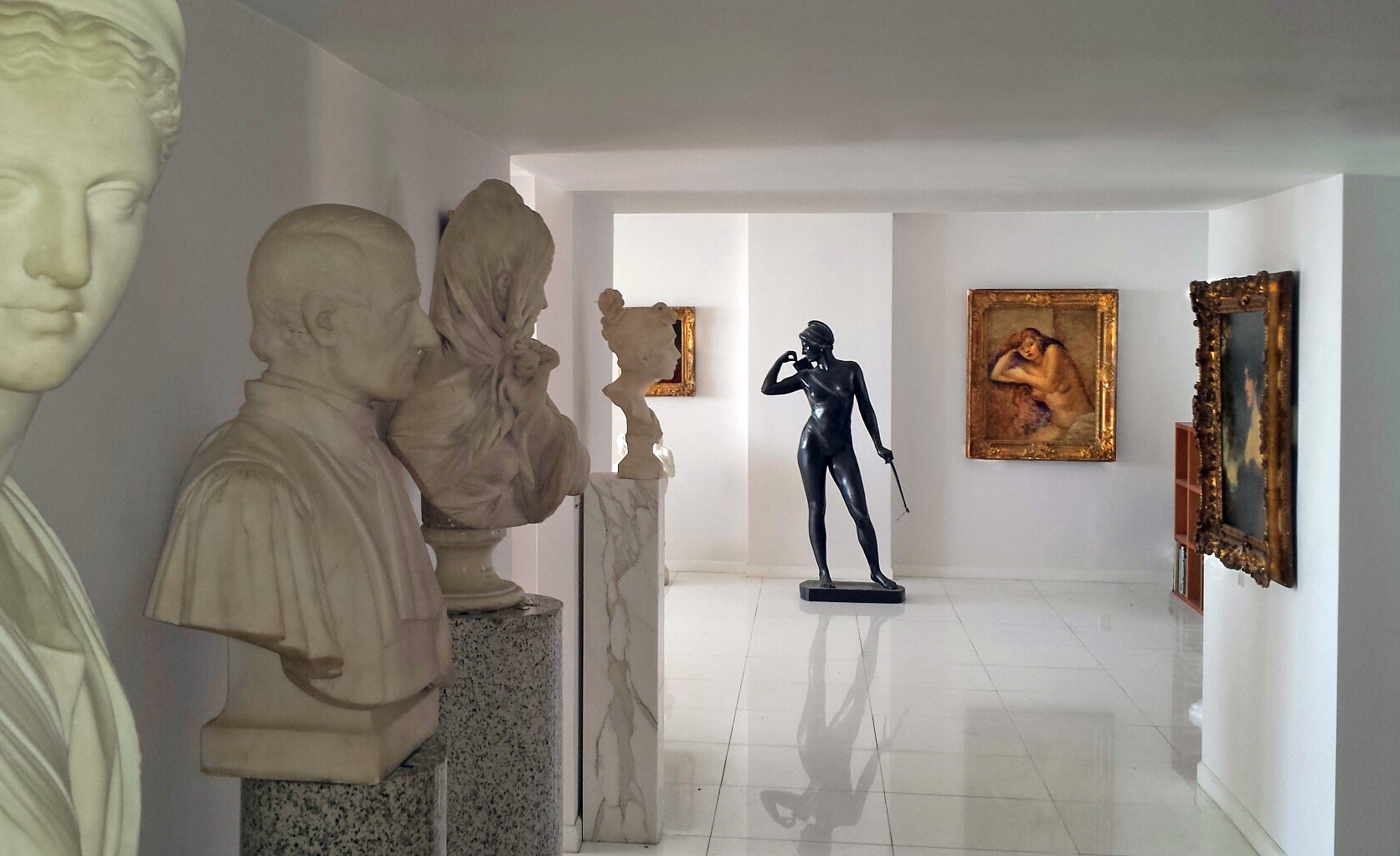
About the Seller
4.9
Gold Seller
These expertly vetted sellers are highly rated and consistently exceed customer expectations.
Established in 2005
1stDibs seller since 2016
102 sales on 1stDibs
Typical response time: 1 hour
- ShippingRetrieving quote...Ships From: Miami, FL
- Return PolicyA return for this item may be initiated within 3 days of delivery.
More From This SellerView All
- A ray of light in the forest - Solitary Man Surreal LandscapeBy Hector GarridoLocated in Miami, FLHector Garrido is an American book cover illustrator. He illustrated numerous science fiction, horror and adventure book covers, including all the covers for the Baroness series of pulp novels, and covers for the Destroyer series. He also illustrated romance and gothic novels, and Nancy Drew and Hardy...Category
1970s American Realist Landscape Paintings
MaterialsAcrylic
- Civil Rights, Racial Justice Little RockBy Philip EvergoodLocated in Miami, FL"Civil Rights." Evergood's early commentary on racial issues in the 1950s depicts four black men gagged, roped and hanging from a tree. In the background, imprisoned blacks look on through a barbed-wire fence. Whites watch in horror but do nothing to help. Meanwhile, a two-legged and three-headed serpent who symbolizes evil - wraps himself around the tree that physically and symbolically separates the races. This is an important work in the history of American art. It may be one of the very earliest examples of a major American painter doing a major work that challenges racial segregation and injustice at a time when no one else would. The title of the work is inspired by a Historic Supreme Court decision on racial segregation. The Little Rock...Category
1950s American Realist Figurative Paintings
MaterialsOil
- Philip Evergood, Little Rock, Oil on Canvas, 1955 - "Civil Rights."By Philip EvergoodLocated in Miami, FL"Civil Rights." Evergood's early commentary on racial issues in the 1950s depicts four black men gagged, roped and hanging from a tree. In the background, imprisoned blacks look on through a barbed-wire fence. Whites watch in horror but do nothing to help. Meanwhile, a two-legged and three-headed serpent wraps himself around the tree that physically and symbolically separates the races. This is an important work in the history of American art. It may be one of the very earliest examples of a major American painter doing a major work that challenges racial segregation and injustice at a time when no one else would. The title of the work is inspired by a Historic Supreme Court decision on racial segregation. The Little Rock...Category
1950s American Realist Figurative Paintings
MaterialsOil
- George Washington Marine Procession New York Presidential Inauguration, Life MagBy Robert RiggsLocated in Miami, FL"The Great Man Comes to Take His Oath" Life Magazine Spread, July 4th, 1960, This epic narrative depicts the celebration of George Washington's inauguration, en route to Federal Hall...Category
1930s American Realist Figurative Paintings
MaterialsOil
- Saturday Evening Post cover, August 29, 1959.By John Ford ClymerLocated in Miami, FLThis work was painted in 1958 ( per the label from Illustration House. It was published in 1959. This is very common in the publishing world where a world of art is commissioned t...Category
1950s American Realist Landscape Paintings
MaterialsOil, Board
- Pulp Magazine Marine Combat Scene Shoot Out in Blue NoirLocated in Miami, FLWhat makes this work important? It's not that it's a commissioned artwork for a men's 60s pulp adventure magazine depicting the instant a soldier is shot. The big point of the painting is how brilliantly the formal elements are thought out, designed, and executed. John McDermott tells a story using a complex figural composition in an unexpected wide-angle vision. The work is as abstract as it is representation. His use of light is significant because it creates a high-contrast two-color style that bears the mark of its creator. This is a work done by a master artist/illustrator without peers compared to artists living today. If the contemporary art world gave awards for draftsmanship, painting technique, and graphic design .... John McDermott would win the highest accolades. Initialed lower left - unframed John McDermott (August 30, 1919 – April 20, 1977), also known under the pen names J.M. Ryan and Mariner, was an American illustrator and author noted for action and adventure illustrations.[1] McDermott worked as an in-between and effects animator for Walt Disney Studios and as a US Marine combat artist,before establishing himself as a cover illustrator for 1950s paperbacks and pulp magazines such as Argosy, American Weekly, and Outdoor Life. Under his J.M. Ryan pen name, he wrote the novels The Rat Factory (1971), a derogatory satire of Walt Disney and the Disney studio; Brooks Wilson Ltd (1967), on which the 1970 film Loving was based; and Mother's Day (1969) about Ma Barker. Under his own name, he novelized director-writer Bo Widerberg's screenplay for the 1971 film Joe Hill, which would be his final published book. Early life John Richard McDermott was born 30 August 1919 in Pueblo, Colorado, the younger of two sons of Henry McDermott, an oil broker. McDermott was a young child when his father committed suicide.[4] The family eventually moved to Los Angeles where McDermott's mother, Hazel, worked in a beauty parlor. He graduated from Hollywood High School in 1936. Although he had had no formal art education, he took a job as an artist at Walt Disney Animation Studios. Career Disney At Disney, McDermott worked as an in-betweener and effects animator on Brave Little Tailor, Pinocchio, The Reluctant Dragon and Fantasia. His experiences while working at Disney, particularly during the time of the 1941 Disney animators' strike, would later become the basis for his 1969 satirical novel The Rat Factory. McDermott left Disney to fight with US forces during World War II. US Marines McDermott World War II sketch titled "Buddy is Wounded" On September 29, 1942, McDermott enlisted with the US Marine Corps. He served as a "pistol and palette" combat artist assigned to the map-making section. As a sergeant with the III Amphibious Corps, McDermott was involved in battles in the South Pacific theater of war, documenting the Guam, Okinawa and the Guadalcanal Campaigns. McDermott considered his wartime years to be his art education. "In the Marines, as a combat artist, I traveled with the troops and for three years got all the drawing opportunity anyone could want. My work changed enormously during this time and I’m sure it was due to constant drawing, every single day, from life, just putting down what I saw around me. In a few instances it was a dangerous kind of scholarship." According to the Marine Corps history journal Fortitudine, McDermott was so prolific that his contemporary style pen-and-ink sketches became easily recognizable to both Marines, from published work in Leatherneck Magazine, and civilians, from glossy copies supplied by the Marine Corps to the nation's press.His wartime art appears in World War II history books and is displayed at the Pentagon and the National Museum of the Marine Corps. Illustration Following the end of World War II, McDermott moved from California to New York City to work as a freelance illustrator. McDermott made his reputation drawing modern action, war and adventure scenes. His work adorned the covers and inside story pages of popular pulp magazines of the 1950s such as Argosy, Adventure, Blue Book, Outdoor Life and American Weekly. McDermott's illustrations appeared on numerous covers of 1950s paperback novels published by Dell, Fawcett Gold Medal, Bantam Mystery and others. His action graphics were geared toward thriller and detective genres, such as Donald Hamilton's Matt Helm books Murderers' Row and The Betrayers. He also created covers for science fiction comic titles such as Voyage to the Deep[citation needed] and horror-themed paperbacks such as the classic 1955 science fiction novel The Body Snatchers...Category
1960s American Realist Figurative Paintings
MaterialsIllustration Board, Gouache
You May Also Like
- Electric DreamsBy Kathleen KeiferLocated in Los Angeles, CAKathleen Keifer is a California-based internationally collected artist. She is a leading force of the New California Realism. With a high level of technical virtuosity Keifer creates...Category
21st Century and Contemporary American Realist Figurative Paintings
MaterialsCanvas, Acrylic
- Alfa Romeo Auto ShowLocated in Long Island City, NYSimon’s automotive illustrations have been featured in Road & Track, Sports Car International, Automobile, Thoroughbred and Classic Cars, Classic and Sportscar, and Vintage Motorsport magazines. Favorite projects document automotive racing history, and he has designed over 60 original automotive racing posters for such clients as UNOCAL, Michelin, BF Goodrich, SVRA’s Bahama Vintage Grand Prix, and a series of Monterey Auction posters. Simon designed and illustrated the cover of the Indianapolis 500...Category
Late 20th Century American Realist Landscape Paintings
MaterialsIllustration Board, Acrylic
- The Young ArtistBy Grant WoodLocated in Palm Desert, CA"The Young Artist" is an oil on panel painting made in 1926 by Grant Wood. The work is signed lower right, "Grant Wood". The painting size is 11 x 14 x 1 inches. The framed size is 2...Category
Early 20th Century American Realist Landscape Paintings
MaterialsOil, Panel
- ScoutingBy Frank Tenney JohnsonLocated in Palm Desert, CA"Scouting" is an oil on canvas painting by Frank Tenney Johnson. The framed piece measures 23 3/4 x 27 3/4 x 3 1/4 inches. Johnson was well-known for his work of the American west, particularly for his portrayal of cowboys at night, lit by moonlight. Johnson utilized knives and fingers when painting, so his work is recognizable for its distinctive marks. Provenance: Biltmore Galleries, Scottsdale...Category
Early 20th Century American Realist Landscape Paintings
MaterialsCanvas, Oil
- Navajo CampBy Gerard Curtis DelanoLocated in Palm Desert, CA"Navajo Camp" is an oil on panel painting by Gerard Curtis Delano. The painting is signed lower left "Delano". The framed piece measures 31 x 36 3/4 x 1 7/8 inches. Delano was a pai...Category
Early 20th Century American Realist Landscape Paintings
MaterialsPanel, Oil
- America 2017, New York, urban architecture, subtle colorBy Gregory FruxLocated in Brooklyn, NYOil on canvas Dr. Rowland S. Russell PhD. writes about his experience directly witnessing Greg's practice as a “plein air” artist: Whether he’s portraying quiet scenes from Brooklyn...Category
2010s American Realist Landscape Paintings
MaterialsOil, Canvas
Recently Viewed
View AllMore Ways To Browse
American Vintage Book
Surreal Landscape
Retro Girl Art
Surreal Vintage
Surreal Vintage Art
Ray Of Light
Retro Book Covers
Light Blue Book
Retro Forest Painting
Gothic America
Vintage Light Rays
Surreal Man
Adventure Books
American Gothic Painting
Gothic Vintage Art
Vintage Book Cover Blue
Realist Forest Paintings
Girl Adventure
